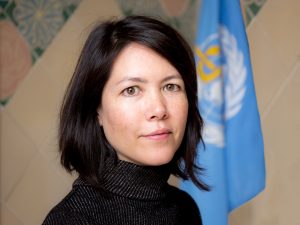Affordable healthcare for all is a central objective of the World Health Organization (WHO), and should be targeted by its Member States as well. But is this achievable in times of crisis?
Text: Dietmar Schobel
The World Health Organization (WHO) defines universal health coverage as “Everyone can use the quality health services they need without financial hardship”. The European Pillar of Social Rights asserts that “Everyone has the right to timely access to affordable, preventive and curative health care of good quality”. Affordable healthcare for all is also an objective that all countries in Europe have committed to through the Sustainable Development Goals of the United Nations. But what are the prerequisites for achieving these goals in the current times of crisis, which are marked by the COVID-19 pandemic, the war in Ukraine, high inflation and an impending economic downturn?
An unmet need for health services and catastrophic health spending are two key indicators of financial protection in health systems – that is, affordable access to healthcare. The higher the rate in each case, the less likely it is that healthcare is affordable for people. An unmet need for health services occurs when people need healthcare but do not use it for financial reasons, because of waiting times or because services are too far away. According to Eurostat, the statistical office of the European Union (EU), in 2019 on average 3 percent of people in the EU reported an unmet need for a medical examination or treatment. The differences between the individual Member States were immense. While in Estonia around 18 percent were unable to meet their needs for examinations or treatments, in Malta this figure was only 0.4 percent.
We know that in most cases it is not a question of emergency care. That kind of healthcare works well in most European countries.
CHARLES NORMAND, PROFESSOR OF HEALTH POLICY AND MANAGEMENT AT THE UNIVERSITY OF DUBLIN, TRINITY COLLEGE

“We know that in most cases it is not a question of emergency care. That kind of healthcare works well in most European countries,” explains Charles Normand, Professor of Health Policy and Management at the University of Dublin, Trinity College. However, unmet needs for a medical examination or treatment are frequently linked to treatments that may be important, but not urgent. Concrete examples include cataract surgery, diabetes treatment, high blood pressure and hip replacements. Families with a relatively low income and a large number of children are disproportionately affected by unmet health needs.
Can people afford to pay for healthcare?
Expenditure on health that triggers financial hardship in households is defined as catastrophic health spending. Households with catastrophic health spending may not be able to afford to pay for other basic needs like food, housing and heating. The WHO Barcelona Office for Health Systems Financing is monitoring affordable access to healthcare in the WHO European Region (53 countries in Europe and Central Asia). It has found that the incidence of catastrophic health spending ranges from under 3 percent of households in France, Germany, Ireland, Slovenia, Spain and the United Kingdom to over 15 percent in Bulgaria, Georgia, Latvia, Lithuania, the Republic of Moldova and Ukraine. There are also major differences in the incidence of impoverishing health spending (the share of households pushed into poverty, or deeper into poverty, due to out-of-pocket payments). 0.3 percent of households in Slovenia were affected by this, compared to 9.0 percent in Ukraine. “Our analysis shows that out-of-pocket payments for healthcare – particularly for outpatient medicines – lead to financial hardship for households even in the richest countries in Europe. In every country it is households with low incomes that are most likely to experience catastrophic health spending,” summarises Sarah Thomson, Senior Health Financing Specialist at the WHO Barcelona Office.
In every country it is households with low incomes that are most likely to experience catastrophic health spending.
SARAH THOMSON, SENIOR HEALTH FINANCING SPECIALIST AT THE WHO BARCELONA OFFICE

Using data up to 2019, the WHO Barcelona Office provides a baseline for the situation in around 40 countries in Europe before the COVID-19 pandemic. “Thinking of the likely impact of the pandemic, the war in Ukraine and the current economic situation on affordable access to healthcare, our research shows the importance of acting quickly to address gaps in coverage and reduce out-of-pocket payments for people with low incomes. This is also a lesson from policy responses to the financial crisis in 2008,” explains Sarah Thomson. In an article published in 2021, she and colleagues explored a question that has increased in urgency in the current situation: “How resilient is health financing policy to economic shocks?”
A more adequate response during the pandemic
By analysing the COVID-19 Health System Response Monitor (a joint undertaking by the WHO Regional Office for Europe, the European Commission and the European Observatory on Health Systems and Policies), this research found that countries generally responded more adequately to the COVID-19 pandemic in comparison to the global financial crisis. While austerity measures implemented in many countries of the European Union in the years after 2008 tended to result in a decline in the performance of health systems and undermined progress towards universal health coverage, measures to ensure affordable access to healthcare during the pandemic were implemented relatively quickly and with the necessary financial support. This ranged from additional funds for health workers and healthcare facilities to deferring social health insurance contributions, giving uninsured people access to publicly financed healthcare, ensuring free access to COVID-19 services (including testing) and reducing user charges (co-payments) for other health services.
A 2019 report by the WHO Barcelona Office for Health Systems Financing describes the types of policies most likely to make healthcare more affordable. The “actions that strengthen progress towards universal health coverage” include efforts to cover the whole population – such as integrating every single person living in a country into the social health insurance system instead of making this dependent on a job or payment of contributions, for example. In contrast, according to both of the experts approached by Healthy Europe on the basis of the evidence available, user charges and voluntary health insurance are unlikely to achieve desired effects, i.e. savings, a more efficient use of resources or better healthcare, and thus should be largely or completely avoided. The 2019 report shows how countries can mitigate the negative impact of user charges by exempting low-income households and regular users of healthcare from co-payments and introducing income-based caps on co-payments. “At the same time, it is also necessary to evaluate the benefit of health services and to ration them accordingly,” emphasises Charles Normand.
Countercyclical measures
The 2021 report “Spending on health in Europe: entering a new era” by the WHO Regional Office for Europe advocates countercyclical measures as a response to economic shocks. If there is a drop in economic performance, countries are likely to need more investment in health systems – rather than a reduction in spending. And there should be a strong focus on supporting socially disadvantaged groups of people.
This is because the need for health services is usually greater at times of crisis, and households with lower incomes are usually most affected. It remains to be seen how far the governments of the European countries listen to these messages and act upon them over the coming weeks, months and years. After all, it must be assumed that this means not just better health for a larger number of people, but also a better foundation for potential recovery of the economy and better preparation for future waves of infections.
Nine out of ten people with financial problems
In Romania 90 percent of people with a cancer diagnosis encounter financial difficulty. This was discovered by an “analysis of the socio-economic costs of cancer in Romania” published in 2021 by Clara Volintiru from Bucharest University of Economic Studies and her colleagues. Their conclusion is based on the assumption that people who suffer from cancer in Romania in most cases will need complementary medical services and products that fall outside the capacity or ability of public healthcare to deliver timely care and diagnosis, and that the costs for this would in turn exceed their average savings. The analysis is considered a starting point for Romania’s National Cancer Plan, which could and should be an important part of Europe’s Beating Cancer Plan. The latter was approved by the European Commission in February 2021 and is one of the essential elements of the planned European Health Union.
